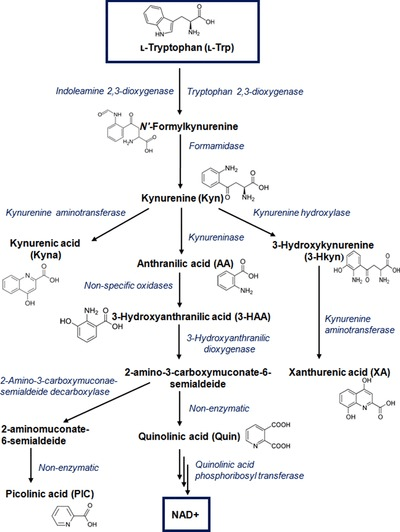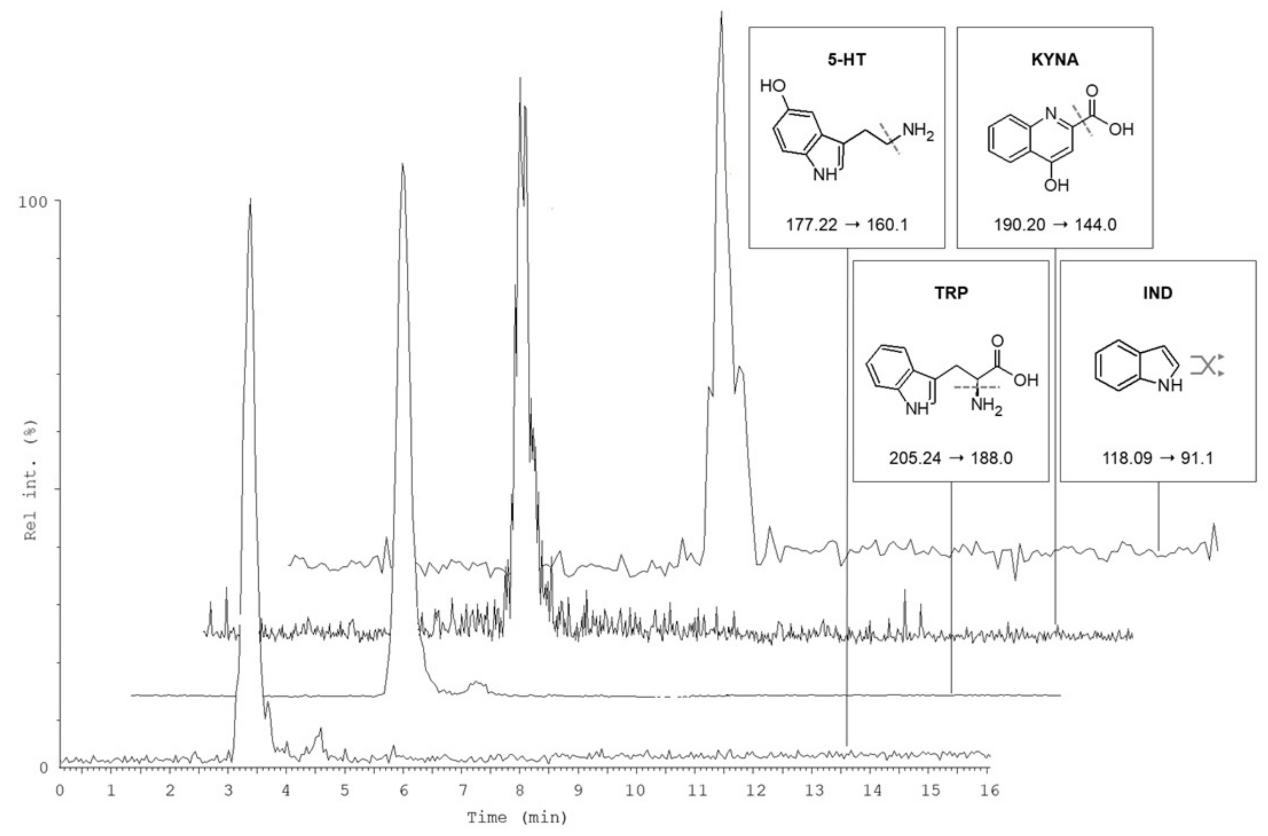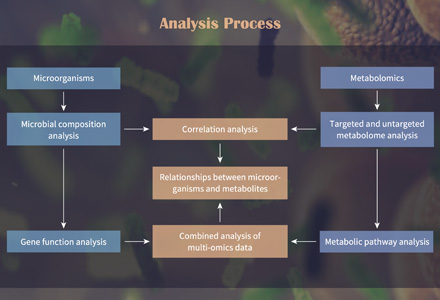Tryptophan Analysis Service
Submit Your Inquiry- Service Details
- Case Study
Tryptophan is an essential amino acid for the human body. It participates in protein synthesis and is the precursor of many important biologically active molecules. Tryptophan metabolism plays an important role in maintaining the body's homeostasis. Tryptophan metabolic pathway may play an important role in the occurrence and development of many physiological disease. We use deuterated tryptophan as an internal standard to correct the matrix effect to a certain extent to improve the accuracy and reproducibility of quantitative analysis. The activated carbon adsorption method is used to adsorb and remove the endogenous tryptophan and its metabolites in the plasma, so that the matrix is closer to the original biological matrix, making it a substitute matrix for constructing a standard curve, and improving the accuracy of quantitative analysis results.
Creative Proteomics offers rapid determination of tryptophan and its metabolites in many types of samples based on high performance liquid chromatography-tandem mass spectrometry (HPLC-MS/MS) techniques and liquid chromatography mass spectrometry (LC-MS) methods. High-quality analytical reports for the evaluation of the content of tryptophan and its metabolites can be obtained. Exploring the relationship between the change pattern of tryptophan and its metabolites and biological processes is important for finding effective targets, diagnosis of related diseases and disease monitoring.
 Figure 1. Scheme of ʟ-tryptophan metabolism via kynurenine pathway. (Sadok 2017).
Figure 1. Scheme of ʟ-tryptophan metabolism via kynurenine pathway. (Sadok 2017).
Advantages of Our Tryptophan Analysis Service
- Great specificity and accuracy of the analyte
- Short analysis cycle and high-throughput measurement of multiple sample types
- Stable and reliable analysis technology and experienced analysis researcher
- Using HPLC-MS platform to accurately determine the content of tryptophan and its metabolites
- Provide comprehensive solutions and competitive prices
Workflow of Tryptophan Analysis
The peak shape obtained in the experiment is good, and the peaks of the target compound and the internal standard substance are not interfered by impurities or endogenous substances in the plasma. The sample pretreatment of this method is simple and convenient, the analysis time is short, and it has the advantage of high throughput, which is conducive to the determination of large sample volumes. Using deuterated tryptophan as an internal standard can reduce the errors caused by sample pretreatment and ionization to a certain extent. LC-MS is used for detection, quantitative analysis results of trace sample substances
 Figure 2. Tryptophan analysis service workflow.
Figure 2. Tryptophan analysis service workflow.
Detection method: standard curve method, internal standard method
Mobile phase: ultrapure water and methanol (v/v, 45/55) containing 0.2% formic acid and 5 mmol/l ammonium acetate
Injection volume: 4 μl
Flow rate: 0.3 ml/min
Elution mode: isocratic elution
Analysis time: 3 min
Reactive ion: positive ion electrospray ionization (ESI)
Monitoring mode: Multi-reaction monitoring mode
Electrospray voltage: 5500 V
Curtain air pressure: 25 psi
Atomizing gas pressure: 50 psi
Auxiliary gas pressure: 50psi
Precision (RSD): ≤ 20%
Average recovery rate: 108.40%
Average matrix effect: 83.55%
Analysis content:
- Calibration of standard straight lines
- Screening of the best mass spectrometry parameters
- Precision, accuracy and stability test
- Specific test
- Standard curve and lower limit of quantification
- Extraction recovery rate and matrix effect
- Chromatogram raw image and data collection
- Quantitative analysis of tryptophan and its metabolites
List of Tryptophan and Tryptophan Metabolism Analysis
| Tryptophan | 3-Hydroxykynurenine | Kynurenine | 5-Hydroxytryptophan (5-HTP) | Serotonin (5-Hydroxytryptamine) |
| N-Acetylserotonin | Melatonin | Kynurenic Acid | Anthranilic Acid | 3-Hydroxyanthranilic Acid |
| Xanthurenic Acid | Quinolinic Acid | Picolinic Acid | Indole-3-acetic Acid | Indole-3-pyruvic Acid |
| Indole-3-lactic Acid | Tryptamine | 5-Hydroxyindole-3-acetic Acid | 5-Methoxytryptamine |
Sample Preparation of Tryptophan Analysis
| Sample Type | Recommended Quantity |
|---|---|
| Protein Extracts | 10-50 μg |
| Plasma/Serum | 100-500 μL |
| Tissues | 20-100 mg |
| Urine | 1-5 mL |
| Bacterial Cultures | 1-10 mL |
| Cell Culture Media | 1-10 mL |
| Plant Extracts | 50-200 mg |
| Food Products | Variable |
Delivery
- Detailed experimental protocol
- Selection of blank matrix and internal standard
- Sample preparation
- Optimization of chromatographic separation conditions
- Optimal parameter setting of HPLC-MS equipment
- Chromatogram raw image and data analysis report
- Quantitative analysis of tryptophan and its metabolites
- Customized analysis report
Applications of Tryptophan Analysis
Protein Characterization and Quantification
Accurate quantification of tryptophan residues within proteins. Provides insights into the structural nuances of proteins.
Neurotransmitter and Metabolite Profiling
Facilitates neurotransmitter profiling for understanding mood and sleep regulation. Aids in exploring neurological disorders and potential therapeutic interventions.
Dietary Assessment and Nutritional Studies
Allows assessment of tryptophan intake for evidence-based dietary recommendations. Contributes to advancements in nutritional science.
Clinical Research and Disease Biomarker Discovery
Identifies and quantifies potential biomarkers associated with various diseases. Enables advancements in diagnostics and personalized medicine.
We use high performance liquid chromatography-tandem mass spectrometry and LC-MS method to establish a simple, fast, sensitive, and low sample consumption method for the accurate quantitative determination of tryptophan and its metabolites. Creative Proteomics wholeheartedly provide you with stable and reliable analysis tools to meet your diverse analysis needs.
References
- Sadok I, Gamian A, Staniszewska M M. Chromatographic analysis of tryptophan metabolites. Journal of Separation Science. 2017;40(15):3020-3045.
- Draher J. HPLC Determination of Total Tryptophan in Infant Formula and Adult/Pediatric Nutritional Formula Following Enzymatic Hydrolysis, Journal of AOAC International 2019;102(5):1567-1573.
Case: Development and Application of a VAMS-LC-MS/MS Method for Comprehensive Analysis of Tryptophan-Related Biomarkers in Small Blood Microsamples
Background
The study aimed to establish a robust analytical method for the simultaneous analysis of tryptophan (TRP) and 23 TRP-related biomarkers using VAMS (Volumetric Absorptive Microsampling) coupled with LC-MS/MS. This method offers a convenient and minimally invasive approach for biomarker assessment in dried whole blood microsamples.
Sample
Whole blood microsamples were collected using Mitra® VAMS microsamplers, providing a practical means for obtaining small volumes (10 μL) for subsequent analysis. Method development and validation utilized blank and fortified blank blood VAMS samples obtained from healthy mice.
Technical Methodology
Liquid Chromatography and Mass Spectrometry
- MS and MS/MS spectra were acquired using direct infusion in the ESI source of 1 μg/mL solutions.
- ESI+ and ESI− ionization modes were employed for analyte selection.
- Pentafluorophenyl (PFP) column was chosen for optimal retention of hydrophilic compounds.
- Mobile phase optimization involved a gradient elution with 0.3% formic acid in acetonitrile and water (50/50, v/v).
- The chromatographic run was 16 minutes with a flow rate of 0.25 mL/min.
VAMS Microsample Pretreatment
- Method development and validation utilized the standard addition method with blank and fortified blood VAMS samples.
- Extraction procedure optimization included investigation of organic solvents, aqueous percentage, and pH.
- Optimized extraction involved a combination of ultrasound-assisted extraction (UAE) and vortex-assisted extraction (VAE).
- VAMS sampling and drying times, as well as volume accuracy, were determined for whole blood samples.
VAMS-LC-MS/TS Method Qualification
- Parameters assessed included absolute recovery, precision, matrix effect, carryover, selectivity, linearity, sensitivity, and stability.
- Matrix effect was in the 87–96% range, and no carryover was observed for VAMS samples.
- The method exhibited selectivity, satisfactory sensitivity (0.1–25 ng/mL LOQ), and correlation coefficients >0.9987.
- Stability tests indicated medium-term stability, benchtop stability, and autosampler stability, all within acceptable ranges.
- Accuracy assays on real samples demonstrated absolute recovery values in the 90–107% range.
Results
The LC-MS/MS method demonstrated high sensitivity, with LOQ values ranging from 0.1 to 25 ng/mL for the 24 target biomarkers.
VAMS microsampling provided satisfactory recovery values (>85%) for all analytes, and precision values were <9.6%.
The method exhibited good selectivity, with correlation coefficients (>0.9987) for calibration curves.
Successful application of the method to murine whole blood microsamples, detecting all compounds in volumes as low as 10 μL.
No stability issues observed for at least 30 days, indicating the potential of VAMS sampling and analysis in biomarker studies.
 LC-MS/MS chromatogram of a whole blood VAMS sample from a mouse (female).
LC-MS/MS chromatogram of a whole blood VAMS sample from a mouse (female).
Reference
- Protti, Michele, et al. "Volumetric absorptive microsampling (VAMS) for targeted LC-MS/MS determination of tryptophan-related biomarkers." Molecules 27.17 (2022): 5652.







